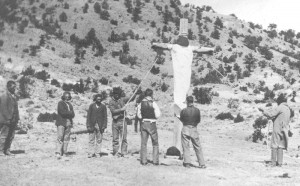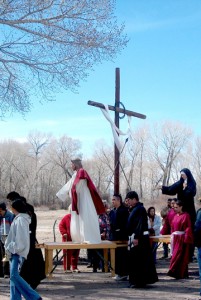This week, I got to attend a lecture by Professor Carlo Severi on Doña Sebastiana, a worshipped symbol of death in the Catholic cult called the Penitente Brotherhood. The Penitente Brotherhood, made up of Spanish-Americans, began in New Mexico. The presence of Doña Sebastiana is not the only interesting tradition that arose in this isolated community; the Brotherhood practiced self-flagellation in the belief that they should experience Christ’s suffering.
I was interested in looking farther into the ritualistic practices of the Penitente Brotherhood. Historical records have helped researchers today learn about the Brotherhood. The work of Charles Lummis proved invaluable in painting a picture of the Brotherhood’s rituals when he had the opportunity to watch and photograph a crucifixion in 1888[1].
The ritual involved recreating the Passion of Christ. According to Lummis, he waited for the Holy Week, when he knew the crucifixion and other ritualistic acts of self-flagellation would occur. Lummis had to be persistent to obtain permission to photograph and attend the ritual, since condemnation of their practices had led the Penitentes to be very secretive. What he saw, included a procession where men whipped themselves, and one man even wore a pack of cactus with thorns that dug into his back. Lummis’s description of the crucifixion itself demonstrated how fully the participants believed in their rituals. Thomson writes, “As they tightened the ropes, the man on the cross ‘sobbed like a child,’ Lummis reported, not because of the pain but because he was ashamed that they were not using nails instead”[2].
One of Lummis’s photographs.
http://www.charleslummis.com/penitente.htm
The Penitente Brotherhood is still active today, although they don’t do self-flagellation anymore. However, they are still very secretive in their practices. One ritual that an outsider was allowed to attend involved extinguishing thirteen candles and then praying in the darkness, to symbolize Jesus dying[3]. The Penitentes have also permitted onlookers for their procession on Good Friday, the exact events of which vary in each Penitentes community. Other than these practices, it must also be noted that charity and sacrifice are important values for members of the Brotherhood[4].
Rituals of the Penitente brotherhood today.
http://cozine.com/2010-march/los-penitentes-del-valle/
Understanding the rituals of the Penitente Brotherhood today is valuable in understanding a current cultural group, and also in understanding their rituals and reasons behind those rituals in the past. In archaeology, this technique of using behavior of a culture today to understand a similar or ancestral people is called analogy. Talking to the descendants of a group are invaluable, especially when dealing with the ethics of studying a culture. As interesting as the rituals of the Penitente Brotherhood are, they also represent real people’s culture and have to be respected in the past and present.
[1] Mark Thomson, “Encounter with the Penitentes”, in American Character: The Curious Life of Charles Fletcher Lummis and the Rediscovery of the Southwest (New York: Arcade Publishing, 2001), Accessed 11/10/13 http://www.charleslummis.com/penitente.htm
[2] IBID.
[3] Ruben E. Archuleta, “Los Penitentes del Valle”, Colorado Central Magazine, Accessed 11/10/13, http://cozine.com/2010-march/los-penitentes-del-valle/
[4] IBID.


